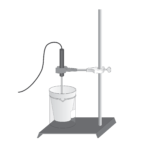Experiments
Here are experiments our science specialists have selected to support this IB* topic.

Determining the Enthalpy of a Chemical Reaction
Experiment #13 from Advanced Chemistry with Vernier
In this experiment, you will
- Use Hess’s law to determine the enthalpy change of the reaction between aqueous ammonia and aqueous hydrochloric acid.
- Compare your calculated enthalpy change with the experimental results.

Burning Accelerants
Experiment #6 from Forensic Chemistry Experiments
- Compare the heat of combustion for two accelerants: the crime scene evidence and samples from arson suspects.
- Calculate the heat of combustion in kJ/g.
- Use your data and calculations to identify which suspect had the same accelerant as that used at the crime scene.
- Educational Standard
- International Baccalaureate (IB) 2025
- Subject
- Chemistry
- Organizing concepts
- Reactivity 1. What drives chemical reactions?
- Subtopics
- Reactivity 1.1—Measuring enthalpy changes
- Level
- Standard level and higher level
* The IB Diploma Program is an official program of the International Baccalaureate Organization (IBO) which authorizes schools to offer it. The material available here has been developed independently of the IBO and is not endorsed by it.
